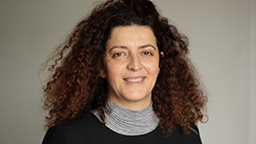Neuberufen 2016: Prof. Dr. Ester Simoes Baptista Ferreira

Fakultät für Kulturwissenschaften Lehr-/Forschungsgebiet: Naturwissenschaften in der Konservierung und Restaurierung
Studium der Angewandten Chemie und Organischen Chemie an der Universidade Nova de Lisboa, Portugal; Studium der Konservierungswissenschaften an der DeMontfort University in Leicester, Großbritannien
Promotion „New approaches towards the identification of natural yellow dyes in ancient textiles“ an der University of Edinburgh, Großbritannien
Berufliche Stationen (u. a.)
- Laborantin an der University of Edinburgh, Großbritannien
- Postdoktorandin in der Studiengruppe Molekulare Malerei am FOM Institute AMOLF, Niederlande
- Gastdozentin/Expertin für analytische Strategien an der ETH Zürich
- Leiterin des Kunsttechnologischen Forschungslabors des Schweizerischen Instituts für Kunstwissenschaft, Schweiz
- Gründungsmitglied der Users‘ Group for Mass Spectrometry and Chromatography
When I was a student I was always fascinated by how well designed experiments can shed light on the most complex questions, help make sense of the world and aid in the search for the truth. I found logic beautiful and elegant. In chemistry, this drew me close to using analytical strategy to learn about a situation or an object.
Art in its many forms has the ability to communicate instantly quite complex feelings and emotions. I never felt the need to analyse it but simply enjoyed being surrounded by music, paintings or literature. Already during my chemistry degree I realised chemistry plays an important role in the creation and preservation of art objects and very quickly decided to combine them in my work.
Following traces on paintings is perhaps one of the most interesting aspects of my work. The painting under the microscope is another world, on the one hand looking so closely at and below the surface of a painting makes us understand how they were made but most importantly it makes us realise that a painting change and can change quite dramatically with time and the environment. Understanding the causes of these changes and improve preservation strategies has been one of the driving forces of my research.
My favourite equipment: I have specialized throughout the years in mass spectrometric techniques and these remain my favourite set of tools.
I've chosen to go back to university because in Academia there is freedom, the will and the means to innovate and the exchange with students is a good source of ideas. Also it is time to pass on some of the experience.
The main message I try to communicate to students: curiosity, open mindedness, independent thinking, confidence to question.
I like to prioritise on quality, collaboration and state-of-the-art research.
The last good film I saw: "The Salt of the Earth" by Juliano Salgado and Wim Wenders with the great photographer Sebastião Salgado. It is beautifully filmed and narrated and it has many depths but Salgado’s concern to give life back to the land that had fed him has a particular impact.
Juni 2016
